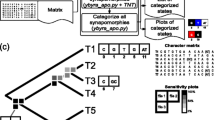Abstract
Sequencing and documenting a sample of homologous DNA stretches is prone to copying errors in a way rather analogous to the biological replication process. Previous attempts at obtaining representative mtDNA sequences, typically of the control region, for evolutionary studies or forensic purposes have yielded rather unsatisfactory results in many cases. The key ingredient in pinpointing problems with given data is the phylogenetic analysis of closely related mtDNAs within the framework of an established worldwide phylogeny that is supported by coding region information. We develop some general rules by which likely errors in data tables can readily be detected without rereading whole sequences repeatedly. Following these guidelines, one can expect to lower the error rate by at least an order of magnitude, although it will still be hard to beat the mitochondrial gamma polymerase in precision.
Similar content being viewed by others
Author information
Authors and Affiliations
Additional information
Received: 30 January 2001 / Accepted: 2 April 2001
Rights and permissions
About this article
Cite this article
Bandelt, HJ., Lahermo, P., Richards, M. et al. Detecting errors in mtDNA data by phylogenetic analysis. Int J Leg Med 115, 64–69 (2001). https://doi.org/10.1007/s004140100228
Issue Date:
DOI: https://doi.org/10.1007/s004140100228




